 ?Mathematical formulae have been encoded as MathML and are displayed in this HTML version using MathJax in order to improve their display. Uncheck the box to turn MathJax off. This feature requires Javascript. Click on a formula to zoom.
?Mathematical formulae have been encoded as MathML and are displayed in this HTML version using MathJax in order to improve their display. Uncheck the box to turn MathJax off. This feature requires Javascript. Click on a formula to zoom.ABSTRACT
Freshwater fish are usually unpopular with people, mainly because of their unappealing earthy and fishy smell. Comprehensive two-dimensional gas chromatography is a relatively new analytical technique. Finally, different parts (the dorsal meat, belly meat, dark meat, skin, intestines, and gills) were investigated by comprehensive two-dimensional gas chromatography coupled with time-of-flight mass spectrometry (GC×GC-TOFMS) to explore their characteristic volatile components. In this study, a total of 49, 48, 61, 70, 73, and 65 volatile components were isolated in these six groups of samples, respectively, by GC×GC-TOFMS. Of these, 6, 7, 10, 13, 11, and 11 characteristic (ROAV ≥ 1) volatile compounds were identified in this study, including: Hexanal, Octanal, Nonanal, Heptanal, Decanal, 1-Heptanol, 1-Octen-3-ol, 2,4-Decadienal and (E,E)-2,4-Nonadienal, the majority of which were aldehydes and alcohols. The intensity range of fishy smells were identified, from strongest to weakest, as follows: gills, intestines, skin, dark meat, and belly/dorsal meat.
Introduction
Freshwater resources and varieties are diverse, and the fish production ranks first in the world. Through continuous development of freshwater fish aquaculture, the country’s yield (China) of freshwater fish increases year-on-year, with an annual harvest of 6.068 million tons in 2018, the highest in world aquaculture statistics.[1] However, fresh fish cannot be stored in vivo and the earthy smell of freshwater fish is not accepted by many consumers which result in considerable limitations on the product’s marketability. The formation of earthy-smelling substances is influenced by many factors, mainly the large amount of cyanobacteria or radiobacteria, such as anabaena, tremor, etc. The secondary metabolites produced by these algae and other microorganisms penetrated into the fish body through the gills, skin and intestinal epithelial cells, accumulatively resulted in the characteristic fishy odor.[Citation2] In addition, some short-chain aldehydes and ketones produced by the degradation of endogenous enzymes and oxidative cleavage of fatty acids in fish can also cause a fishy smell.[Citation3]
In addition to the current limitations in Chinese domestic freshwater fish food processing technology, as a high protein and low-fat food resource, the full value of fish has not been fully utilized. Moreover, fresh fish contains a high water content of more than 80% and is highly susceptible, which exacerbates the earthy smell and further limits the consumption. Therefore, new processing techniques are needed to improve the quality of the fresh-water fish and the consumer’s acceptance of fresh-water fish products. Hence, researches on the flavor of freshwater fish contribute to addressing the challenge of the fishy odor. Freshwater fish such as grass carp, are mainly sold fresh at present. Their flavors vary greatly and, therefore, the analysis of characteristic flavor components of different parts of fish is of great help in establishing unique earthy odor substances. Furthermore, aquatic products have unique flavors, so their examination will certainly enrich the theoretical knowledge of food flavor chemistry foundation.
As one of the four major fish species in China, grass carp accounts for a very large proportion of the country’s aquaculture industry. Grass carp meat is tender, delicious, and nutritious. It contains high-quality protein, vitamins, and minerals that are beneficial to the human body, as well as the omega-3 and omega-6 fatty acids, which are of great importance for human health and nutrition.[Citation4–Citation6] Freshwater fish, whether cultured or naturally caught, have a certain earthy smell and volatile flavor compounds, such as the source of food odors, which are important indexes for evaluating food quality and provide important characteristic information assisting in the evaluation and improvement of food flavor quality, product classification and identification, as well as guidance in production, processing, and utilization. However, there are few reports on the volatile compounds detected in different body parts of fish.
At present, gas chromatography-mass spectrometry (GC-MS), compared to other technologies, is widely applied in identifying food odorants. Comprehensive two-dimensional gas chromatography is a multi-dimensional chromatographic separation technology developed in the 1990 s, which, more recently, has been used in combination with time-of-flight mass spectrometry (GC×GC-TOFMS) as an efficient separation technique. Two-dimensional gas chromatography connects two columns with different polarities through interface series technology to achieve a better separation effect in complex samples. A modulator is installed between the two chromatographic columns, in which the samples are collected and focused by the modulator before entering the second chromatographic column for separation.[Citation7–Citation9] The technique can be used for both one-dimensional and comprehensive two-dimensional analysis. Since this invention, the separation efficiency, resolution, sensitivity, and separation time were also shortened. Furthermore, this system has a high peak capacity, fast analysis speed, and can produce a large amount of information.[Citation10] The fast scanning and powerful deconvolution of TOFMS also offers advantages of high sensitivity, good reproducibility and high throughput, and can effectively solve the problems of low sensitivity and low resolution of one-dimensional GC-MS. SPME-GC×GC-TOFMS is widely applied in food flavor studies around the world, including metabonomics, food safety, environment, flavoring, tobacco, wine, Chinese medicine volatilization, and semi-volatile component analysis. Zhu et al.[Citation11] detected 528 volatile substances in a Moutai liquor sample using GC×GC-TOFMS while Welke et al.[Citation12] identified 334 volatile compounds in Brazilian merlot wine by this new technology and Martyna et al.[Citation13] analyzed the volatile composition of 15 Brassica cultivars both raw and cooked samples using SPME-GC×GC-TOFMS. Perestrelo et al.[Citation14] identified 103 volatile compounds in Madeira wine by SPME-GC×GC-TOFMS even correctly judging the year of the wine by its compounds. The current domestic studies of grass carp largely focus on the freshness.[Citation15,Citation16] However, as far as we are concerned, studies on the characteristic odor in different body parts of the fish are rare and not thorough, since one-dimensional GC-MS (including MMSE-GC-MS and SPME-GC-MS) only preliminarily identified the major volatile flavor compounds by far.[Citation17]
This present work, therefore, aimed to comprehensively analyze the characteristics of volatile components in six body parts of the fish by means of SPME-GC×GC-TOFMS for the purpose of providing research methods and a theoretical basis for the formation mechanisms and quality controls of grass carp flavor.
Materials and methods
Sample preparation
In early June 2018, six farmed grass carp (3,000 ± 110 g in weight and 46.1 ± 3.5 cm in length) were purchased from PuDong New Area, Shanghai, China, and within 30 min, delivered directly to the lab alive in an inflatable foam bags containing a lot of water. After a heavy blow to the head, the fish were quickly scaled, gutted, and washed. The samples of six parts were stored in refrigerator at −80°C in separate polyethylene bags until tested.GC×GC-TOFMS sample: the samples were treated according to Zhang’s method.[Citation18]
GC× GC-TOFMS analysis
The volatiles in different parts of grass carp were isolated by headspace solid-phase microextraction (HS-SPME), and SPME-GC×GC-TOFMS was used to analyze the volatiles in samples. Sixty-five μm PDMS/DVB SPME fiber was activated at 250°C for 30 min, the vial was then extracted in a constant temperature water bath at 50°C for 45 min and the fiber was desorbed in the inlet of the GC before taken out for detection and analysis.
The system comprised an Agilent 7890 GC equipped with a TOF-MS (Pegasus 4D, Leco Corporation, USA) for acquiring mass spectrometry data from the GC×GC, according to the previously described methods with some modifications.[Citation19,Citation20] The chromatographic column system consisted of a one-dimensional column DB-5 MS (0.25 mm, J&W Scientific) and a two-dimensional column DB-17HT (0.1 um, J&W Scientific), with two columns connected in series.
Conditions of Chromatography: The injector temperature was 250°C and the injection mode was non-split. The primary oven temperature was programmed as follows: initial temperature of the column was set 40°C with no initial hold, rising to 100°C (5°C/min), then rising further to 180°C (2°C/min), until finally rising to 240°C for 5 min (5°C/min). The gas flow rate was 1.2 mL/min and the carrier gas was He. The MS conditions were as follows: the electron impact ionization energy was 70 eV with an ion source temperature at 220°C, the acquisition voltage of 1,700 V, the transmission line temperature of 280°C, while the acquisition rate was 100 spectra per second, ranging from 20 to 400 u.
ROAV analysis method for volatile components
Referring to Zhu’s method,[Citation21] odor activity values (OAVs) were adopted to assess the contribution of each volatile compound to the overall flavor of the sample, therein.OAV = C/T (where C is for concentration of substance and, T stands for the threshold of sensation). Due to the variety and complexity of food flavors, individual quantitative (absolute concentration) analysis would be laborious and costly. The purpose of volatile component analysis is to screen out a number of compounds that contribute the most to a particular food flavor and represent its dominant characteristics. Therefore, the relative olfactory activity value (ROAV) is generally measured in the field of food flavor research,[Citation22,Citation23] with ROAVmax = 100. The ROAVi is calculated as follows:
where Ci, and Ti are the relative contents of the volatile substance and its threshold, while Cs and Ts represent the relative contents of the components that contributing more to the sample flavor and its thresholds. In this assay, area normalization method was used to determine the relative content of volatile substances in different samples.[Citation24]
Data analysis
All data presented as means ± standard deviations. GC×GC-TOFMS used Leco’s software to automatically identify peaks with a signal-to-noise ratio greater than 800. The spectrum library used was NIST/EPA/NIH Version 2.0. One-way analysis of variance (ANOVA) and the Tukey method (including LSD and Duncan’s test) was carried out by means of SPSS 17.0 (SPSS Inc., Chicago, IL, USA.) and significant differences were obtained when P < .05 level. All graphs were drawn using Origin 8.5 (Origin Lab Corp., Hampton, USA).
Result and discussion
GC×GC-TOFMS analysis
The volatile flavor of grass carp was found to be mostly composed of aldehydes, ketones, alcohols, hydrocarbons, and aromatic and other compounds by GC×GC-TOFMS (). The relative content of alcohols and carbonyl compounds exceeds 80%, while the relative content of aldehydes in gills was the highest, as indicated in . In , it can be clearly seen that a total of 49, 48, 61, 73, 65, and 70 volatile components were detected in these six groups of samples, respectively. Furthermore, as shown in , the gills were not only identified as having more volatile compounds, but they also presented higher measurements in the GC peak area in comparison with the other parts of grass carp, the peak area of the dorsal and belly meat were relatively low, which are related to the number of compounds detected to some extent. Total ion flow chromatography 1D (a) and 2D (b) of these six parts were displayed in –.
Table 1. Volatile compounds identified in different parts of grass carp as measured by GC×GC-TOFMS.
Figure 1. The relative content of volatile compounds in different parts of grass carp by GC×GC-TOFMS.
Figure 2. The number of volatile compounds in different parts of grass carp by GC×GC-TOFMS.
Figure 3. The total area of the volatile components in different parts of grass carp by GC×GC-TOFMS.
ROAV value analysis
The contribution of each volatile component to the overall flavor of food does not directly correspond to its relative content, but is decided by sensory threshold and the ratio of its concentration. Therefore, to further determine the flavor compounds in the samples, ROAV was also performed in this study, and the GC×GC-TOFMS analysis results (ROAV values) in these six groups of grass carp were shown in . The content of 1-Octen-3-ol was found to be relatively high except for the gills and intestines, while the content of 2, 4-decadienal was relatively high in the intestines and gills, and their thresholds are relatively low (1 µg/kg and 0.07 ug/kg, respectively), indicating that they contributed greatly to the overall odor formation of the sample. Therefore, the ROAVmax of 1-Octen-3-ol in the first four samples and the ROAVmax of 2,4-decadienal in intestines and gills were defined as 100, and the ROAV of other volatile compounds were calculated by the formula 2.3 (ROAV analysis method for volatile components). These results are presented in . shows the comparison of the characteristic volatile compounds that have highest ROAVs in these six groups of samples. 1-Octen-3-ol, Hexanal, Nonanal and Octanal, all had higher ROAV in six groups of samples, thus they contribute more to the overall flavor. The ROAV of 2,4-Decadienal and (E)-2-Nonenal were only detected in the dark meat, skin, intestines, and gills, where gills were highest, suggesting that this is the reason why the strongest strong earthy smell emanates from the fish samples.
Table 2. Relative odor activity values in different parts of grass carp by GC×GC-TOFMS.
Figure 4. Characteristic volatile compounds with the highest ROAVS in different parts of grass carp.
Figure 5. Total ion flow chromatography 1D (a) and 2D (b) of belly meat extracted by HS-SPME and analyzed by GC×GC-TOFMS.
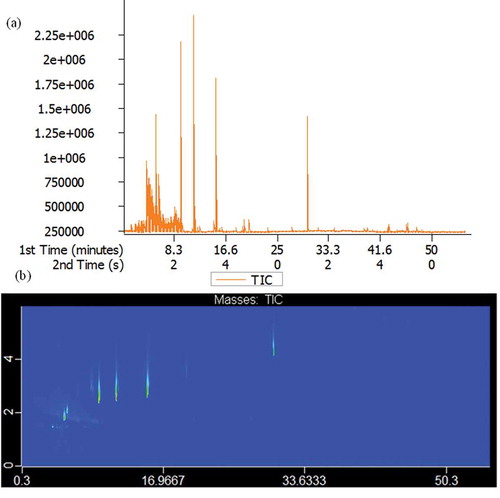
Figure 6. Total ion flow chromatography 1D (a) and 2D (b) of dorsal meat extracted by HS-SPME and analyzed by GC×GC-TOFMS.
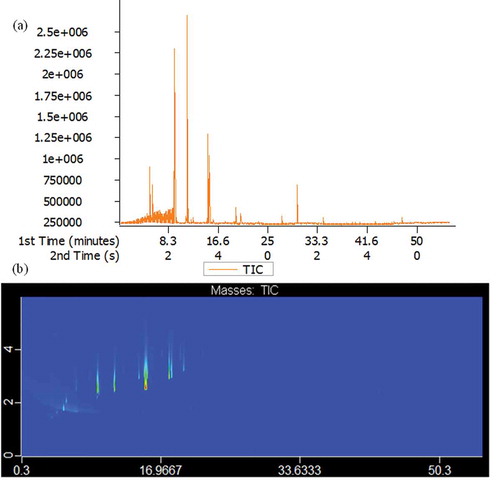
Figure 7. Total ion flow chromatography 1D (a) and 2D (b) of dark meat extracted by HS-SPME and analyzed by GC×GC-TOFMS.
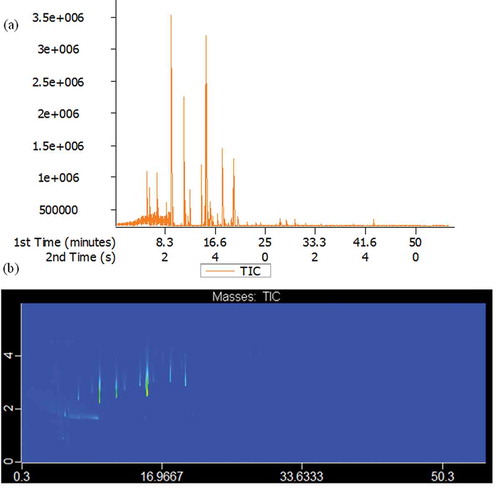
Figure 8. Total ion flow chromatography 1D (a) and 2D (b) of skin extracted by HS-SPME and analyzed by GC×GC-TOFMS.
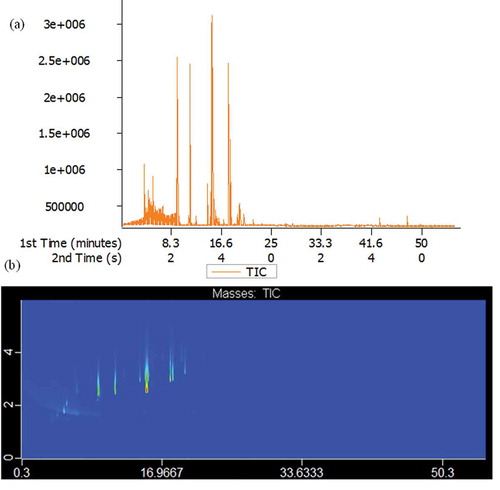
Figure 9. Total ion flow chromatography 1D (a) and 2D (b) of intestines extracted by HS-SPME and analyzed by GC×GC-TOFMS.
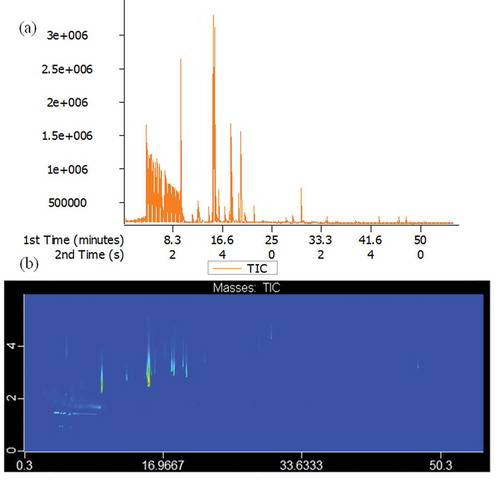
Figure 10. Total ion flow chromatography 1D (a) and 2D (b) of gills extracted by HS-SPME and analyzed by GC×GC-TOFMS.
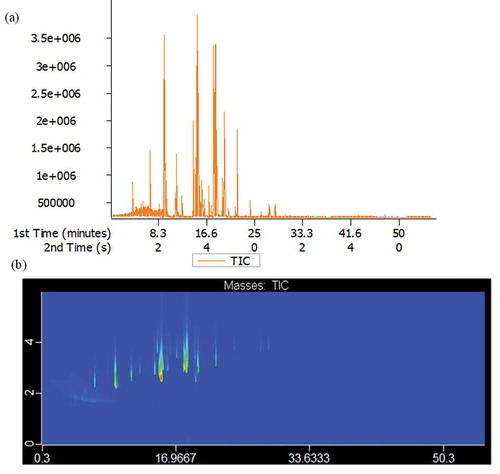
As displayed in , chatacteristic and dominant volatile compounds contribute greatly to the overall odor formation of grass carp. ROAV ≥ 1, namely, chatacteristic volatile compounds, the larger the ROAV, the greater the contribution of the components to the overall flavor profile of the samples. Dominant volatile compounds (0.1 ≤ ROAV < 1) could also play important roles in modifying the smell of these samples. 6, 7, 10, 13, 11, and 11 characteristic volatile compounds with ROAVs greater than 1 were identified in this study (). The largest number of characteristic substances were detected in the skin. It is them that determine the integral flavor characteristics of grass carp.
Table 3. Chatacteristic and dominant volatile compounds detected in six parts of grass carp samples.
Volatile components analysis of grass carp
Aldehyde volatile compounds
Aldehydes, as important volatile flavor compounds, are usually thought to be formed by the formation of hydroperoxides from unsaturated fatty acids such as arachidonic acid linoleic acid and linolenic acid under the action of lipoxygenase, which may constitute the characteristic flavor of the meat. They are the most abundant flavor compounds isolated from grass carp, and their threshold is generally low. The C6-C9 aldehydes generally have a fresh taste similar to that of fruits and vegetables, due to their low threshold, and have a great influence on flavor.[Citation25–Citation27] Here, 7, 7, 21, 16, 19, and 25 kinds of volatile aldehydes were identified from these six groups of samples, and their corresponding relative contents were 9.63%, 15.03%, 29.71%, 23.67%, 44.39%, and 49.86%, respectively. Among them, the species and relative content were highest in the fish gills. Hexanal, Octanal, Nonanal, and Heptanal, which are saturated aldehydes that, have been found in many freshwater fish,[Citation28–Citation30] were also identified in our study. Of the six groups, the intestine exhibited the highest relative content of hexanal (22.61%), with a lower threshold of 4.5 ug/kg. The ROAV was highest in all body parts, indicating it to be the key flavor compound of grass carp. Previous studies have shown that hexanal is the main product of the degradation of unsaturated fatty acid peroxide,[Citation31] with the auto-oxidation of linoleic acid-producing 13-hydroperoxide, and the fracture of 13-hydroperoxide producing hexanal with its grassy and rancid taste.[Citation32,Citation33] For the belly and dorsal meat, no benzaldehyde was discovered, in which with fish smell or almond note, came from the oxidation degradation of linoleic acid.[Citation34] A large number of studies have shown that benzaldehyde has a bitter almond or sweet aroma.[Citation35] Compared with other parts of the grass carp, the relative content of octanal and nonanal in the intestines and the content in the gills were the highest, respectively. These are produced by oxidation of oleic acid, and are important sources of the earthy flavor of fish.[Citation36,Citation37] (E)-2-Octenal and (Z)-2-heptenal have also been proved to be typical fishy taste compounds in many kinds of fish. The threshold of these aldehydes was very low, providing an additive effect on fishy smell.[Citation38] (Z)-2-heptenal was not discovered in the dorsal or belly meat in our study. Other unsaturated olefins with high ROAVs due to their low threshold, such as (E, E)-2,4-Nonadienal and 2,4-Decadienal were only detected in the skin, intestines, dark meat and gills, providing reason for their strong fishy smell.
Ketone volatile compounds
Since fewer species of ketones were found in the samples, and they showed lower relative content and higher threshold value than some aldehyde, their contribution to the flavor of grass carp was not considered significant. Ketones can be produced by fat oxidative degradation or by the Maillard reaction and enhance a fishy smell.[Citation39] It is characterized by the smell of eucalyptus, fatty and burnt, and exhibits stronger floral characteristics as the carbon chain grows.[Citation40] Ketones containing C5-C7 atoms are associated with positive organoleptic properties.[Citation41] There were 5, 4, 11, 8, 7, and 5 kinds of ketone compounds detected in these six groups of samples, respectively, with relative contents of 27.33%, 21.60%, 10.10%, 22.75%, 18.75%, and 7.24%, respectively. One important volatile ketone identified in this study, namely, 2,3-Octanedione was detected in all samples. However, its threshold was not found and it may contribute to the fishy smell of the grass carp. 2-Heptanone was detected in all samples, due to its low content and low threshold, so it is speculated that it had a small contribution to the volatile flavor of grass carp.
Alcohol volatile compounds
Alcohols are derived from fatty acid oxidases acting on polyunsaturated fatty acids. They accounted for a large proportion of volatile components in the grass carp and, although the threshold was relatively high, they can be considered to have a great impact on the flavor of grass carp. The aroma threshold of saturated alcohol is much higher than that of unsaturated alcohol, which is why the latter contributes greatly to the flavor of meat.[Citation42] The percentages of alcohol compounds in these six groups of samples, were relatively high, at 39.26%, 47.95%, 51.45%, 40.83%, 16.88%, and 24.97%, respectively.
In this study, two important saturated alcohols were identified, namely 1-Penten-3-ol with a grassy note[Citation43] and 1-Octen-3-ol with a mushroom flavor, and their respective odor thresholds are 400 and 1 μg/kg. It has been reported that these alcohols exist in both freshwater fish and marine fish,[Citation44,Citation45] and that unsaturated alcohols contribute significantly to the flavor of fish result from their low flavor threshold. A few researchers have been reported that 1-Octen-3-ol, a degradation product of the hydroperoxide of linoleic acid, is an important reason for the heavy intense earthy odor of grass carp meat,[Citation46] while others suggested that it was related to the aroma of freshwater fish.[Citation38,Citation47] In this study, the content of 1-Octen-3-ol was highest in the dark meat, accounting for 44.08%. According to ROAV analysis, 1-Hexanol is related to a grassy flavor,[Citation48] and it can, accordingly, play an important role in modifying grass carp flavor (0.1≤ ROAV<1). (E)-2-Octen-1-ol was also detected, which may further promote the smell of fish.
Hydrocarbon volatile compounds
Large quantities of hydrocarbons were also detected in this study, with 15, 15, 12, 29, 18, and 20 extracted from these six groups of samples, respectively. They mainly come from the homogeneous splitting of alkoxy groups in fatty acids. A variety of alkanes (C6-C19) exist in crustaceans and fish volatiles, however, due to their high threshold values, they have little effect on flavor. Alkenes were majorly produced by lipid oxidation, they can form aldehydes and ketones under certain conditions, which can enhance flavor, making them also potential factors in the production of fishy odors.[Citation49,Citation50] Shahidi[Citation51] believes that both saturated and unsaturated hydrocarbons play a smaller role in food flavor formation.
Aromatics and other volatile flavor compounds
The flavor of grass carp is also influenced by the elements in the water environment in which they lived. Benzene, ethylbenzene, naphthalene, and others were detected in this study, possibly related to environmental pollution, and they gave the fish an unpleasant flavor. In addition, some flavor compounds with low thresholds such as furans, acids, and esters were also detected in the fish, which further contribute to the flavor of grass carp. Most furans have a strong meat flavor and a very low aroma threshold.[Citation52] 2-Pentyl-furan was detected in all parts in this study. 2-Ethyl-furan, which has a strong burnt smell,[Citation53] was only detected in the last three samples. The compound, methoxy-phenyl-oxime, was identified in both the dark meat and gills, which would also have an enhanced effect on fishy odor.
Conclusion
Comprehensive two-dimensional gas chromatography is a relatively new analytical technique, it can reseparate the chromatographic peaks which can not be separated by one-dimensional column. The results of GC×GC-TOFMS analysis showed that 49, 48, 61, 70, 73, and 65 characteristic volatile components existed in six parts grass carp samples, most of which were aldehydes and alcohols that have a major contribution to overall odor formation. Compared with MMSE-GC-MS adopted by Wang et al.17 in 2018, more characteristic volatile components, such as (E,E)-2,4-Nonadienal, (E,E)-2,4-Decadienal, 2,4-Decadienal in the dark meat, gills, intestines, and skin in our study. Also, ROAV analysis showed that more characteristic flavor compounds and larger effective peak areas were detected in the gills, intestines, skin, and dark meat, which fully show the characteristics of high peak capacity, high sensitivity, and resolution of comprehensive two-dimensional gas chromatography. The intensity of fishy smells in the samples, from most to least intense, were determined as follows: the strongest were gills, followed by intestines, skin, and dark meat, while dorsal meat and belly meat were the weakest and equivalent. The results will certainly provide a profound basis for in-depth studies of grass carp flavor and should make an important contribution to the field of aquatic products.
Disclosure statement
The authors declare that no conflict of interest exist.
Additional information
Funding
References
- FAO. The State of World Fisheries and Aquaculture 2018-Meeting the Sustainable Development Goals; Food and Agriculture Organization of the United Nations: Rome, 2018; pp 39.
- Guttman, L.; Rijn, J. V. 2-Methylisoborneol and Geosmin Uptake by Organic Sludge Derived from a Recirculating Aquaculture System. Water Res. 2009, 43, 474–480.
- Selli, S.; Prost, C.; Serot, T. Odour-active and Off-odour Components in Rainbow Trout (Oncorhynchus Mykiss) Extracts Obtained by Microwave Assisted Distillation–solvent Extraction. Food Chem. 2009, 114, 317–322.
- Watanabe, T.; Kiron, V.; Satoh, S. Trace Minerals in Fish Nutrition. Aquaculture. 1997, 151, 185–207.
- Connor, W. E.;. Importance of N−3 Fatty Acids in Health and Disease. Am. J. Clin. Nutr. 2000, 71, 171S.
- Sikorski, Z. E.; Kolakowska, A.; Burt, J. R. Postharvest Biochemical and Microbial Changes. Seafood. 1990, 50, 55–76.
- Dallüge, J.; Beens, J.; Brinkman, U. A. T. Comprehensive Two-dimensional Gas Chromatography: A Powerful and Versatile Analytical Tool. J. Chromatogr. A. 2003, 1000, 69–108.
- Mondello, L.; Tranchida, P. Q.; Dugo, P.; Dugo, G. Comprehensive Two-dimensional Gas Chromatography-mass Spectrometry: A Review. Mass Spectrom. Rev. 2008, 27, 101–124.
- Tranchida, P. Q.; Dugo, P.; Dugo, G.; Mondello, L. Comprehensive Two-dimensional Chromatography in Food Analysis. J. Chromatogr. A. 2004, 1054, 3–16.
- Jiang, H.; Wang, J.; Song, L.; Cao, X.; Yao, X.; Tang, F.; Yue, Y. GC×GC-TOFMS Analysis of Essential Oils Composition from Leaves, Twigs and Seeds of Cinnamomum Camphora L. Presl and Their Insecticidal and Repellent Activities. Molecules. 2016, 21, 423.
- Zhu, S.; Lu, X.; Ji, K.; Guo, K.; Li, Y.; Wu, C.; Xu, G. Characterization of Flavor Compounds in Chinese Liquor Moutai by Comprehensive Two-dimensional Gas Chromatography/time-of-flight Mass Spectrometry. Anal. Chim. Acta. 2007, 597, 340–348.
- Welke, J. E.; Manfroi, V.; Zanus, M.; Lazarotto, M.; Zini, C. A. Characterization of the Volatile Profile of Brazilian Merlot Wines through Comprehensive Two Dimensional Gas Chromatography Time-of-flight Mass Spectrometric Detection. J. Chromatogr. A. 2012, 1226, 124–139.
- Wieczorek, M.; Jeleń, H. Volatile Compounds of Selected Raw and Cooked Brassica Vegetables. Molecules. 2019, 24: 391. doi: 10.3390/molecules24030391.
- Perestrelo, R.; Barros, A. S.; Câmara, J. S.; Rocha, S. M. In-depth Search Focused on Furans, Lactones, Volatile Phenols, and Acetals as Potential Age Markers of Madeira Wines by Comprehensive Two-dimensional Gas Chromatography with Time-of-flight Mass Spectrometry Combined with Solid Phase Microextraction. J. Agric Food Chemi. 2011, 59, 3186–3204.
- Qin, N.; Li, D.; Hong, H.; Zhang, Y.; Zhu, B.; Luo, Y. Effects of Different Stunning Methods on the Flesh Quality of Grass Carp (Ctenopharyngodon Idellus) Fillets Stored at 4°C. Food Chem. 2016, 201, 131–138.
- Lv, H.; Hu, W.; Xiong, S.; You, J.; Fan, Q. Depuration and Starvation Improves Flesh Quality of Grass Carp (Ctenopharyngodon Idella). Aquacult. Res. 2018, 49, 3196–3206.
- Wang, H. L.; Zhang, J. J.; Zhu, Y. Z.; Wang, X. C.; Shi, W. Z. Volatile Components Present in Different Parts of Grass Carp. J. Food Biochem. 2018, 42. DOI: 10.1111/jfbc.12668.
- Zhang, J. J.; Shi, W. Z.; Wang, X. C. Odor Characteristics of White Croaker and Small Yellow Croaker Fish during Refrigerated Storage. J. Food Biochem. 2019. DOI: 10.1111/jfbc.12852.
- Gao, W.; Fan, W.; Xu, Y. Characterization of the Key Odorants in Light Aroma Type Chinese Liquor by Gas Chromatography–olfactometry, Quantitative Measurements, Aroma Recombination, and Omission Studies. J. Agric. Food Chem. 2014, 62, 5796–5804.
- Yao, F.; Yi, B.; Shen, C.; Tao, F.; Liu, Y.; Lin, Z.; Xu, P. Chemical Analysis of the Chinese Liquor Luzhoulaojiao by Comprehensive Two-dimensional Gas Chromatography/time-of-flight Mass Spectrometry. Sci. Rep. 2015, 5, 9553.
- Zhu, Y.; Klee, H. J.; Sarnoski, P. J. Development and Characterization of a High Quality Plum Tomato Essence. Food Chem. 2018, 267, 337–343.
- Xu, Y. Q.; Limwachiranon, J.; Li, L.; Ru, Q. M.; Luo, Z. S. Characterisation of Volatile Compounds of Farmed Soft-shelled Turtle (Pelodiscus Sinensis) by Solid-phase Microextraction and the Influence of Matrix pH on the Release of Volatiles. Int. J. Food Sci. Technol. 2017, 52, 275–281.
- Wu, W.; Wu, R.; Tao, N. P. Identification of Volatile Compounds in Cooked Meat of Farmed Obscure Puffer (Takifugu Obscurus) Using Sde and HS-SPME Combined with GC-MS. Adv. Mater. Res. 2013, 706–708, 399–402.
- Sun, L.; Chen, J.; Li, M.; Liu, Y.; Zhao, G. Effect of Star Anise (Illicium Verum) on the Volatile Compounds of Stewed Chicken. J. Food Process Eng. 2014, 37, 131–145.
- Medina, I.; Saeed, S.; Howell, N. Enzymatic Oxidative Activity in Sardine (Sardina Pilchardus) and Herring (Clupea Harengus) during Chilling and Correlation with Quality. Eur. Food Res. Technol. 1999, 210, 34–38.
- Leduc, F.; Tournayre, P.; Kondjoyan, N.; Mercier, F.; Malle, P.; Kol, O.; Berdagué, J. L.; Duflos, G. Evolution of Volatile Odorous Compounds during the Storage of European Seabass (Dicentrarchus Labrax). Food Chem. 2012, 131, 1304–1311.
- Mottram, D. S. Flavour Formation in Meat and Meat Products: A Review. Food Chem. 1998, 62, 415–424.
- Zhou, X.; Chong, Y.; Ding, Y.; Gu, S.; Liu, L. Determination of the Effects of Different Washing Processes on Aroma Characteristics in Silver Carp Mince by MMSE-GC-MS, E-nose and Sensory Evaluation. Food Chem. 2016, 207, 205–213.
- Xie, C.; Ou, C. R.; Cao, J. B.; Tang, H. Q. Analysis of the Volatile Compounds of Vinasse Hairtail through Two Comprehensive Dimensional Gas Chromatography–time of Flight Mass Spectrometry. Mod. Food Sci. Technol. 2014, 30, 234–243.
- Drumm, T. D.; Spanier, A. M. Changes in the Content of Lipid Autoxidation and Sulfur-containing Compounds in Cooked Beef during Storage. J. Agric. Food Chem. 1991, 39, 336–343.
- Sun, J.; Huang, J.; Wang, Q. J.; Chen, Y. F.; Su, X. R. Analysis of Volatile Compounds of Bigeye Tuna (Thunnus Obesus) Meat by Headspace Solid-Phase Microextraction Combined with Gas Chromatography-Mass Spectrometry. Food Sci. 2011, 32, 230–233.
- Wang, L.; Wang, X. C.; Liu, Y. Comparative Analysis of Odor and Volatile Composition of Different Parts of Grass Carp (Ctenopharyngodon Idella) Carcass. Food Sci. 2010, 31, 158–164.
- Ruiz, J.; Garcıa, C.; Muriel, E.; Andrés, A. I.; Ventanas, J. Influence of Sensory Characteristics on the Acceptability of Dry-cured Ham. Meat Sci. 2002, 61, 347–354.
- Chen, W. S.; Liu, D. C.; Chen, M. T. The Effect of Roasting Temperature on the Formation of Volatile Compounds in Chinese-style Pork Jerky. Asian Australas. J. Anim. Sci. 2002, 15, 427–431.
- Mahdieh, I.; Hamid, E.; Behrouz, A. A.; Amir, K. T. M. SPME/GC-MS Characterization of Volatile Compounds of Iranian Traditional Dried Kashk. Int. J. Food Prop. 2018, 21, 1067–1079.
- Tanimoto, S.; Kitabayashi, K.; Fukusima, C.; Sugiyama, S.; Hashimoto, T. Effect of Storage Period before Reheating on the Volatile Compound Composition and Lipid Oxidation of Steamed Meat of Yellowtail Seriola Quinqueradiata. Fish. Sci. 2015, 81, 1145–1155.
- Zhou, Y. Q.; Wang, Z. J. Extraction and Analysis on Fishy Odor-causing Compounds in the Different Part of Carp. Chin. J. Anal. Chem. 2006, 34, S165–S167.
- Iglesias, J.; Medina, I.; Bianchi, F.; Careri, M.; Mangia, A.; Musci, M. Study of the Volatile Compounds Useful for the Characterisation of Fresh and Frozen-thawed Cultured Gilthead Sea Bream Fish by Solid-phase Microextraction Gas Chromatography–mass Spectrometry. Food Chem. 2009, 115, 1473–1478.
- Ruiz, J.; Ventanas., J.; Ramón, C. New Device for Direct Extraction of Volatiles in Solid Samplesusing Spme. J. Agric. Food Chem. 2001, 49, 5115–5121.
- Siek, T. J.; Albin, I. A.; Sather, L. A.; Lindsay, R. C. Comparison of Flavor Thresholds of Aliphatic Lactones with Those of Fatty Acids, Esters, Aldehydes, Alcohols, and Ketones And. J. Dairy Sci. 1971, 54, 1–4.
- Amanpour, A.; Vandamme, J.; Polat, S.; Kelebek, H.; Van Durme, J.; Selli, S. Non-thermal Plasma Effects on the Lipoxygenase Enzyme Activity, Aroma and Phenolic Profiles of Olive Oil. Innovative Food Sci. Emerg. Technol. 2019, 54, 123–131.
- Mansur, M.; Bhadra, A.; Takamura, H.; Matoba, T. Volatile Flavor Compounds of Some Sea Fish and Prawn Species. Fish. Sci. 2003, 69, 864–866.
- Flores, M.; Grimm, C. C.; Toldrá, F.; Spanier, A. M. Correlations of Sensory and Volatile Compounds of Spanish “Serrano” Dry-cured Ham as a Function of Two Processing Times. J. Agric. Food Chem. 1997, 45, 2178–2186.
- Iglesias, J.; Medina, I. Solid-phase Microextraction Method for the Determination of Volatile Compounds Associated to Oxidation of Fish Muscle. J. Chromatogr. A. 2008, 1192, 9–16.
- Josephson, D. B.; Lindsay, R. C.; Stuiber, D. A. Identification of Compounds Characterizing the Aroma of Fresh Whitefish (Coregonus Clupeaformis). J. Agric. Food Chem. 1983, 31, 326–330.
- Deng, J. C.; Wang, X. C.; Liu, Y. Research Progress in Fish Flavor Research. Sci. Technol. Food Ind. 2010, 31, 375–378+383.
- Fernández-Segovia, I.; Escriche, I.; Gómez-Sintes, M.; Fuentes, A.; Serra, J. A. Influence of Different Preservation Treatments on the Volatile Fraction of Desalted Cod. Food Chem. 2006, 98, 473–482.
- Josephson, D. B.; Lindsay, R. C.; Stuiber, D. A. Variations in the Occurrences of Enzymatically Derived Aroma Compounds in Salt-and Freshwater Fish. J. Agric. Food Chem. 1984, 32, 1344–1347.
- Herland, H.; Esaiassen, M.; Cooper, M.; Olsen, R. L. Changes in Trimethylamine Oxide and Trimethylamine in Muscle of Wild and Farmed Cod (Gadus Morhua) during Iced Storage. Aquacult. Res. 2010, 41, 95–102.
- Ma, N.; Pei, F.; Yu, J.; Wang, S.; Ho, C.; Su, K.; Hu, Q. Valid Evaluation of Volatile Flavor Composition of Fresh and Dehydrated Tuber Indicum with Different Drying Methods. CyTA. J. Food. 2018, 16, 413–421.
- Shahidi, F.; Rubin, L. J.; D’Souza, L. A.; Teranishi, R.; Buttery, R. G. Meat Flavor Volatiles: A Review of the Composition, Techniques of Analysis, and Sensory Evaluation. Crit. Rev. Food Technol.. 1986, 24, 141–243.
- Calkins, C.;. A Fresh Look at Meat Flavor. Meat Sci. 2007, 77, 63–80.
- Moon, S. Y.; Cliff, M. A.; Li-Chan, E. C. Y. Odour-active Components of Simulated Beef Flavour Analysed by Solid Phase Microextraction and Gas Chromatography–mass Spectrometry and Olfactometry. Food Res. Int. 2006, 39, 294–308.
